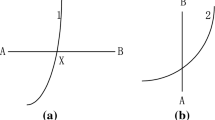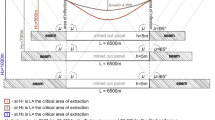Abstract
There has been a significant development in the evaluation of methods to predict ground movement due to underground extraction based on geographical information systems (GIS). In order to make the calculation of the backfill volume of road collapse more convenient, the calculating methods of backfill volumes of straight road collapse and bent road collapse due to mining subsidence are derived based on GIS in this paper. To ensure the calculation accuracy of backfill volume, the interpolation method is used for the calculation of backfill volumes of road collapse in mining subsidence. Calculation procedure: Firstly, the area of arbitrary cross-section of road is calculated by geometric method. Further, the backfill volume of road collapse between the two adjacent cross-sections is the product of the area of cross- section and the calculating step. The total backfill volume of road collapse is calculated by the sum of the backfill volume of road collapse between multiple adjacent cross-sections. Then, the calculating methods are embedded in the GIS platform for calculation. The backfill volume of the railway collapse after the 1–12# mining face is 58,113.25 m3.







Similar content being viewed by others
References
Asadi K, Shakhriar A, Goshtasbi K (2004) Profiling function for surface subsidence prediction in mining inclined coal seams. J Min Sci 40:142–146
Blachowski J (2016) Application of GIS spatial regression methods in assessment of land subsidence in complicated mining conditions: case study of the Walbrzych coal mine (SW Poland). Nat Hazards 84:997–1014
Cao C, Xu PH, Wang YH, Chen JP, Zheng LJ, Cencen N (2016) Flash flood hazard susceptibility mapping using frequency ratio and statistical index methods in Coalmine subsidence areas. Sustainability 8:1–18
Chen SJ, Yin DW, Cao FW, Liu Y, Ren KQ (2016) An overview of integrated surface subsidence-reducing technology in mining areas of China. Nat Hazards 81:1129–1145
Da BY, Wen XZ, Qing Y (2011) Research of mining subsided land reclamation system based on GIS. Appl Mech Mater 130–134:1858–1861
Esaki I, Djamaluddin I, Mitani Y (2008) A GIS- based prediction method to evaluate subsidence-induced damagefrom coal mining beneath a reservoir, Kyushu, Japan. In: Conference on subsidence-collapse SIP
Esaki T, Djamaluddin I, Mitani Y (2008b) A GIS-based prediction method to evaluate subsidence-induced damage from coal mining beneath a reservoir, Kyushu, Japan. Q J Eng Geol Hydrogeol 41:381–392
Hao Y, Hu Z, Nawrot JR (2013) Integrated evaluation of ecological sustainability of a mining area in the western region of China. Int J Environ Sci Dev 4:289
Hood M, Ewy RT, Riddle LR (1983) Empirical methods of subsidence prediction: a case study from Illinois. Int J Rock Mech Min Sci 20:153–170
Ibrahim D, Yasuhiro M, Hiro I (2012) GIS-based computational method for simulating the components of 3D dynamic ground subsidence during the process of undermininG. Int J Geomech 12:43
Jiang YJ, Wang YH, Yan P, Zhao ZH (2018) numerical simulation analysis of instability failure of coal pillar in mine room mining. J Shandong Univ Sci Technol (Nat Sci) 37(5):27–33
Lai X, Cai M, Ren F, Xie M, Esaki T (2006) Assessment of rock mass characteristics and the excavation disturbed zone In the Lingxin coal mine beneath the Xitian river, China. Int J Rock Mech Min Sci 43:572–581
Li XJ, Shao F, Li J, Liu X (2012) Evaluation to damage situation of coal mining subsidence land in mountainous area based on MSPS and GIS. Adv Mater Res 518–523:5692–5696
Malinowska A (2011) A fuzzy inference- based approach for building damage risk assessment on mining terrains. Eng Struct 33:163–170
Malinowska A, Hejmanowski R (2010) Building damage risk assessment on mining terrains in Poland with GIS application. Int J Rock Mech Min Sci 47:238–245
Oh HA, Choi SC, Lee S (2011) Sensitivity analysis for the GIS-based mapping of the ground subsidence hazard near abandoned underground coal mines. Environ Earth Sci 64:347–358
Sheorey PR, Singh KB, Singh SK, Loui JP (2000) Ground subsidence observations and a modified influence function method for complete subsidence prediction. Int J Rock Mech Min Sci 37:801–818
Suh J, Choi Y, Park HD, Yoon SH, Go WR (2013) Subsidence hazard assessment at the Samcheok Coalfield, South Korea: a case study using GIS. Environ Eng Geosci 19:69–83
Suh JW, Choi Y, Park HD (2016) GIS-based evaluation of mining-induced subsidence susceptibility considering 3D multiple mine drifts and estimated mined panels. Environ Earth Sci 75:1
Xiao W, Zhang HY, Zhang JY (2014) GIS-based analysis of LS factor under coal mining subsidence impacts in Sandy Region. J Eng Sci Technol Rev 7:73–78
Yu QG, Zhang HX, Deng WN, Zou YP (2018) the non-symmetric shape of surface subsidence caused by mining. J Shandong Univ Sci Technol (Nat Sci) 37(4):42–48
Zahiri H, Palamara DR, Flentje P, Brassington GM, Baafi E (2006) A GIS-based weights-of-evidence model for mapping cliff instabilities associated with mine subsidence. Environ Geol 51:377–386
Zhang MW, Lv WC, Yao GH (2013) The information acquisition system of subsidence mining-induced based on mobile GIS. In: Proceedings of the eighth international conference on bio-inspired computing: theories and applications (BIC-TA), pp 1165–1173
Zhao DS, Xu T and Tang CA (2004) Numerical simulation of bed separation of overburden strata induced by mining excavation. In: ISRM international symposium/3rd asian rock mechanics symposium (ARMS), pp 475–478
Author information
Authors and Affiliations
Corresponding author
Rights and permissions
About this article
Cite this article
Zhang, J., Liu, L. & Peng, W. The Calculation Method for Backfill Volume of Road Collapse in Mining Subsidence Based on GIS. Geotech Geol Eng 37, 1829–1838 (2019). https://doi.org/10.1007/s10706-018-0726-1
Received:
Accepted:
Published:
Issue Date:
DOI: https://doi.org/10.1007/s10706-018-0726-1




